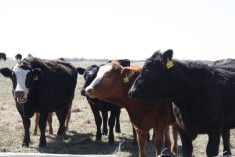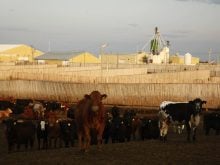This cattle market information is selected from the weekly report from Canfax, a division of the Canadian Cattlemen’s Association. More market information, analysis and statistics are available by becoming a Canfax subscriber by calling 403-275-5110 or at www.canfax.ca.
Fed steers stronger
For the third consecutive week the Canfax fed average was more than $200 per hundredweight, trading at a premium over the Nebraska market.
Fed steers averaged almost $202 per hundredweight while heifers were around $201 per cwt.
Both traded for $333-$337 per cwt. on the rail in Alberta.
Read Also

Flax sector sees omega-3 opportunity
SASKATOON — A global shortage of omega-3 oils could be an opportunity for the flax sector, says an industry official….
Yearling heifers continue to be marketed for less than steers and heifer slaughter continues at a strong pace. It was the second time in a month where western Canadian heifer slaughter volumes exceeded 19,000 head.
Basis levels are usually strongest in May. With more calves beginning to enter the slaughter mix carcass weights will likely decline.
Feeders weaken
The Canfax steer average fell $1 and feeder heifers were down almost $3.50. Volatile cattle futures made it difficult to manage feeding risk and the stronger Canadian dollar depressed American buying interest.
Large volumes of spring feeders were marketed through April with quality and lot size possibly contributing to softer prices.
Alberta steers 800 to 900 pounds averaged $246 per cwt. last week, up slightly from the previous week, while heifers fell to $232. These prices were similar across the western provinces. Ontario steers averaged $251 per cwt. and heifers slipped to $217 per cwt.
Alberta feeders 500-600 lb. averaged $327 per cwt. while heifers were down to $296 per cwt.
Saskatchewan 500-600 lb. steers were $328 and heifers were $289. Manitoba saw steers average $333 per cwt. and heifers $290 per cwt.
Feedlots are still looking for cattle but are not prepared to take on excessive feeding risk. Fed market fundamentals will need to improve to restore feeding profitability and buyer confidence.
Feeder supplies should begin to tighten which will support prices, but this week feeders could see prices edge lower.
Non-fed slaughter down
Spring slaughter cow supplies were manageable and prices were steady. D1, D2 cows ranged $140-$158 to average $148.13. D3 cows ranged $118-$143 to average $131.83. Railgrade cows were $282-$287.
Slaughter bull prices slipped $3.37 to $167.31 per cwt. The stronger loonie discouraged U.S. bids.
Non-fed slaughter was five percent lower than the previous week. Non fed slaughter to date was 104,311, down eight percent. Exports to date are down 26 percent at 86,898.
Normally non fed prices weaken in May but modest supplies and steady demand should keep prices steady.
Beef strong
Boxed beef prices continue at unprecedented levels. The AAA cutout rallied 11 percent from $288 per cwt. in early January to $320 per cwt in mid April.
The cutout averaged $303 per cwt. in the first quarter, up 32 percent from last year and double prices from the first quarter of 2010.
Price support has come from across the carcass. For the week ending April 10, chucks were up 26 percent since the start of the year, loins were up 30 percent, ribs 31 percent and rounds 35 percent.
Thin meats pushed higher after the tremendous rally last year with flank up 40 percent, short plate up 53 percent and brisket up 59 percent. Eighty-five percent trim was up 66 percent in the first quarter to $346 per cwt. compared to $208 per cwt. last year
Beef imports were up 2.4 percent or 1.45 million lb. in the first two months of the year.














